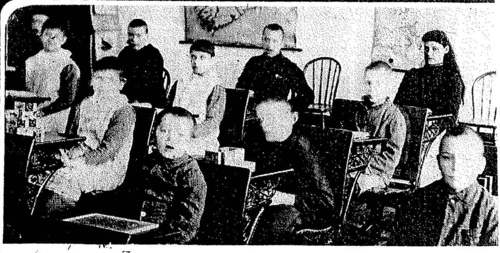Reading Analysis #6:
In the upcoming lecture, we will be discussing and trying to understand the topic of “‘Healthy’ Children and ‘Healthy’ Schools”. However, we were first assigned readings to give us some context on what we will be discussing. Within this topic, the readings pertained to schools that promoted the segregation of “feeble-minded” and “unhealthy” children that did not follow what is considered to be “good health” within the schools.
In Gerald Thomson’s article, “‘Through no fault of their own’: Josephine Dauphinee and the ‘Subnormal’ Pupils of the Vancouver School System, 1911-1941”, he explains the segregation of the “feeble-minded” children from the rest of youth in schools. This segregation of these children was due to the “concern for the social control of the feebleminded… [and] children with mental disabilities were seen as a social threat that had to be isolated like a contagious disease”[1]. There was a fear that their mental inabilities in common sense, or other tasks dealing with school would affect the “normal” children. It is noted in the article that, it was “encouraged to public authorities to expand the auxiliary classes and fund institutional confinement so that the ‘mentality of [the] race may not degenerate’”[2]. In addition to this, it was believed that there must be “a strong preserved Anglo-white majority in British Columbia and the sterilization of mental defectives… who were often non-Anglo/non-white [people]”[3]. In Toronto for instance had a large population of Jewish people, and also had a significant amount of Italians and Chinese people[4]. It is noted that, “Toronto’s social and educational reformers worried about immigration… [and that these people] were perceived as threats to the city’s reputation as ‘Toronto the Good’”[5]. These immigrants that were coming into Canada posed a big issue for not just the city and the way it was perceived, but also affected the education system because these non-white “unhealthy” children were trying to attend school with the other “healthy” children. This concept of “healthy” children is outlined in Mona Gleason’s article, “Race, Class, and Health: School Medical Inspection and ‘Healthy’ Children in British Columbia, 1890-1930”. Gleason explains how “Asian immigrants were condemned as simply incapable of obeying sanitation laws [and] the natives live in unsanitary conditions, [whereas] the white population… obeyed sanitation laws”[6]. The race of people who disobey sanitation laws and don’t live like the white population were considered to be “unhealthy”, which was a problem in schools with the fear of spreading diseases and other medical conditions. In this time, the best way to prevent these illnesses from spreading from the “unhealthy” children to the “healthy” children were to construct a system to detect these diseases. “Reformers legislated their connection to schools and students and concentrated on building mechanisms of surveillance to root out ‘defective’ children”[7]. This method of surveillance worked in some instances but also greatly influenced the segregation and discrimination of different races within the school system.
All of these articles contribute to the main topic that we will be further discussing in our lecture. The topic of “healthy” children and “healthy” schools is an important topic that must be discussed in order to understand the history of childhood and education. These articles depict different ways that schools were segregated, from both being considered “feeble-minded” and “subnormal” as well as not being the white race. All the articles contribute to the wider historiography of the topic, and helps us to better understand this part in Canadian history, which we can also integrate it into our thinking of school systems in present time Canada.
Endnotes:
[1] Gerald Thomson, “‘Through no fault of their own’: Josephine Dauphinee and the ‘Subnormal’ Pupils of the Vancouver School System, 1911-1941,” Historical Studies in Education 18, no.1 (Spring 2006): 52.
[2] Ibid.
[3] Ibid.
[4] Jason Ellis, “‘Inequalities of Children in Original Endowment’: How Intelligence Testing Transformed Early Special Education in North American City School System,” History of Education Quarterly, 53, 4 (November 2013): 404.
[5] Ibid., 404-405.
[6]Mona Gleason, “Race, Class, Health: School Medical Inspection and ‘Healthy’ Children in British Columbia, 1890-1930,” Canadian Bulletin of Medical History, 19, 1 (2002): 97.
[7] Ibid., 98.
Bibliography:
Ellis, Jason. “‘Inequalities of Children in Original Endowment’: How Intelligence Testing Transformed Early Special Education in North American City School System.” History of Education Quarterly, 53, 4 (November 2013): 401-429.
Gleason, Mona. “Race, Class, Health: School Medical Inspection and ‘Healthy’ Children in British Columbia, 1890-1930.” Canadian Bulletin of Medical History, 19, 1 (2002): 95-112.
Thomson, Gerald. “‘Through no fault of their own’: Josephine Dauphinee and the ‘Subnormal’ Pupils of the Vancouver School System, 1911-1941.” Historical Studies in Education, 18, no.1 (Spring 2006): 51-73.
Reflection:
The reason why I chose to incorporate this reading analysis into my ePortfolio was because it deals with two points I want to discuss throughout my ePortfolio. The reading analysis touched on the aspects of disabilities and inabilities that these children in this time faced. Many children were segregated from other children primarily due to their inability to learn like the majority of the children. Some children’s “disabilities” in this time were “feeblemindedness” and being “subnormal”, which greatly influenced their education and their childhood experiences. Not only did their inabilities to learn “normally” effect this, but the fact that they were segregated and discriminated against added to this negative effect. This reading analysis supports my main argument I am trying to make throughout this ePortfolio by showing the effects of segregation and discrimination on children and the effects on their childhood and education.
Header Image from: http://www.thelmawheatley.com/the-asylum-for-idiots-and-feeble-minded-orillia-1876/

Leave a Reply